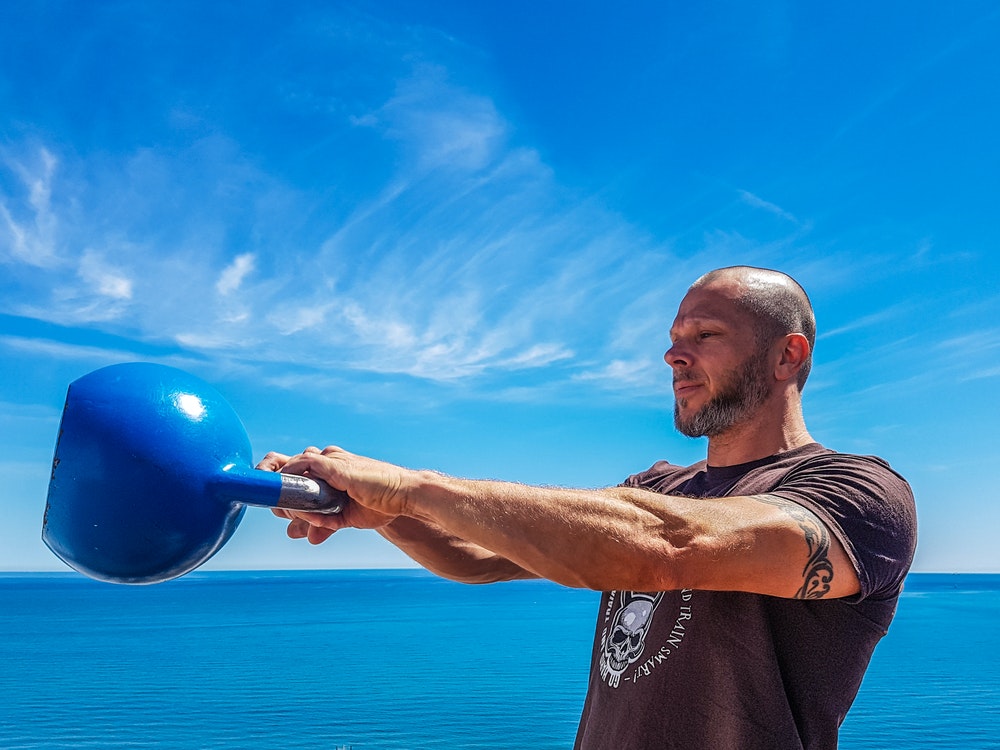Here it is. One of the most comprehensive articles you will ever read to learning the kettlebell swing. But before we start:
It may pay to have a Functional Movement Screen conducted before you start using kettlebells. You can also access an at home screen in my Unlocking Your Movement Online Course which comes free with this course which you can find here. There you will be able to assess whether you have any mobility or movement restrictions that could affect your training. Remember, if you’re not assessing, you’re guessing.
Learning the kettlebell swing can be complex and sometimes difficult. It generally comes down to two things, simplification and progression. By using a simplified approach when learning the kettlebell swing you will be able to focus on the key and essential elements to create the maximum effect. By using a logical progression you will be able to ensure you have the relative skills to progress to another level.
Romanian Deadlift or RDL
The reason I like to teach the RDL before the Deadlift is that it contains a reduced range of motion or ROM, which helps an individual progress into the hip hinge pattern safely and effectively. It can also be taught with a barbell or kettlebell, which helps when minimal equipment is available. The hip hinge pattern in quite often taught poorly, and with the pattern being heavily utilized to recruit the posterior chain it should be given enormous amounts of attention to detail to help reduce flexion and extension injuries of the spine, lower back soreness and soft tissue injuries of the hamstring and glutes just to name a few.
The RDL starts in the top or finish position of the deadlift. Standing upright in a double overhand grip engage the lats by sucking your shoulders to your hips, from here push your hips to the wall and allow your chest to fall. At all times keep your shins vertical but maintain a soft knee.
Once you are loaded in the hip hinge position drive your glutes through to the top position maintaining the set position of the shoulders and lats. The kettlebell version sees the use of a single kettlebell; the same queues and catchwords apply. To start introducing the kettlebell swing, the use of C.A.T. or compensatory action training can be utilized. This utilizes a slow eccentric phase into the movement with a fast drive up. If you are struggling with developing your hip hinge pattern using drills such as your hip hinge patterning drill with a dowel featured in the first video of the section will help.
The Two Hand Kettlebell Swing
After you have achieved a solid deadlift we can look at the kettlebell swing. The swing is a perfect example of the relationship of tension and relaxation that is required for most athletic endeavours. Taught poorly it can do a lot of harm to someone, taught correctly it can fix lower back pain, add kilograms to your deadlift and increase speed and power.
The kettlebell swing is regarded as a great conditioning tool and is also an excellent corrective. There are three main variations when learning the kettlebell swing and they are the two handed, single arm and double kettlebell swing. The kettlebell encourages a correct hip hinge pattern and also reinforces lat activation and shoulder packing. Following on from hip hinge patterning and the varieties of the deadlift, the kettlebell swing introduces the ballistic element to the pattern. Correct and neutral spine must be kept at all times whilst a strong drive from the glutes after engaging the stretch reflex of the posterior chain drives the kettlebell through to the finish position.
Starting a foot length back from the kettlebell, hip hinge down towards the bell. From here you will not be able to reach the kettlebell as like the deadlift, add a slight knee bend but maintain your weight shifted onto your heels. From here your hands will grab the bell and you will suck your shoulders to your hips pull the bell back toward you. It will tip towards you onto its balance point dragging back a little. With your shoulders packed and weight shifted onto your heels, hike or pass the kettlebell high between your thighs. Once your forearms come in contact with your thighs engage your glutes driving you to the top position.
At the top position your lats should be on sucking your shoulders to hips, glutes engaged, abs on and a soft lock of the knees. When the bell is at the top position it should feel like it is floating. From here pause in the top position and allow the kettlebell to fall for as long as possible. Do NOT break at the hips yet. Once the arm comes in contact with the chest pull the bell back into the hip hinge pattern absorbing it with the hips. Maintain neutral spine and a vertical shin. From here drive the bell back to the top position using the glutes.
When placing the kettlebell down let the bell fall as much as possible trying to attack your zipper, absorb the swing like you are about to swing again, add some knee bend and place the bell onto the ground exactly where you picked it up from.
Single Arm & Double Kettlebell Swing
As far as I am concerned the single arm swing is the best version when learning the kettlebell swing due to the difficulty and what it offers. Once you have mastered the two-hand swing we can progress to the single arm and double kettlebell versions. The same set up tips and queues apply but there are subtle differences. The double kettlebell swing challenges the hip hinge pattern by maintaining or increasing the weight used in the two handed swing but removing the fixed hand position of having both hands on one kettlebell. This challenges the loading of the pattern, lat recruitment and packing of the shoulder.
The single arm swing adds an anti rotation component to the swing. Resisting the pull of the kettlebell to the side that is loaded poses a challenge to most people starting out with kettlebells. Maintaining a level shoulder position in both the top and loaded hip hinge positions is essential for spine integrity and power through the movement. The spare or free arm follows the kettlebell through the movement and helps with the drive forward by throwing the arm on the forward portion of the movement. Neutral spine and a level shoulder position must be kept at all times.
So there you have it, three types of swings and the simplified approach to learn them all. Be sure to take your time when learning the kettlebell swing and you will reap the rewards in movement, strength and performance.






